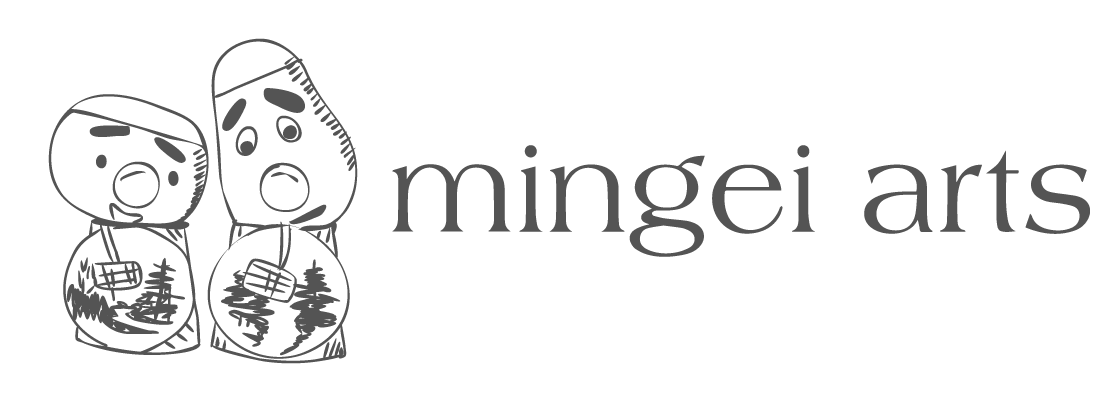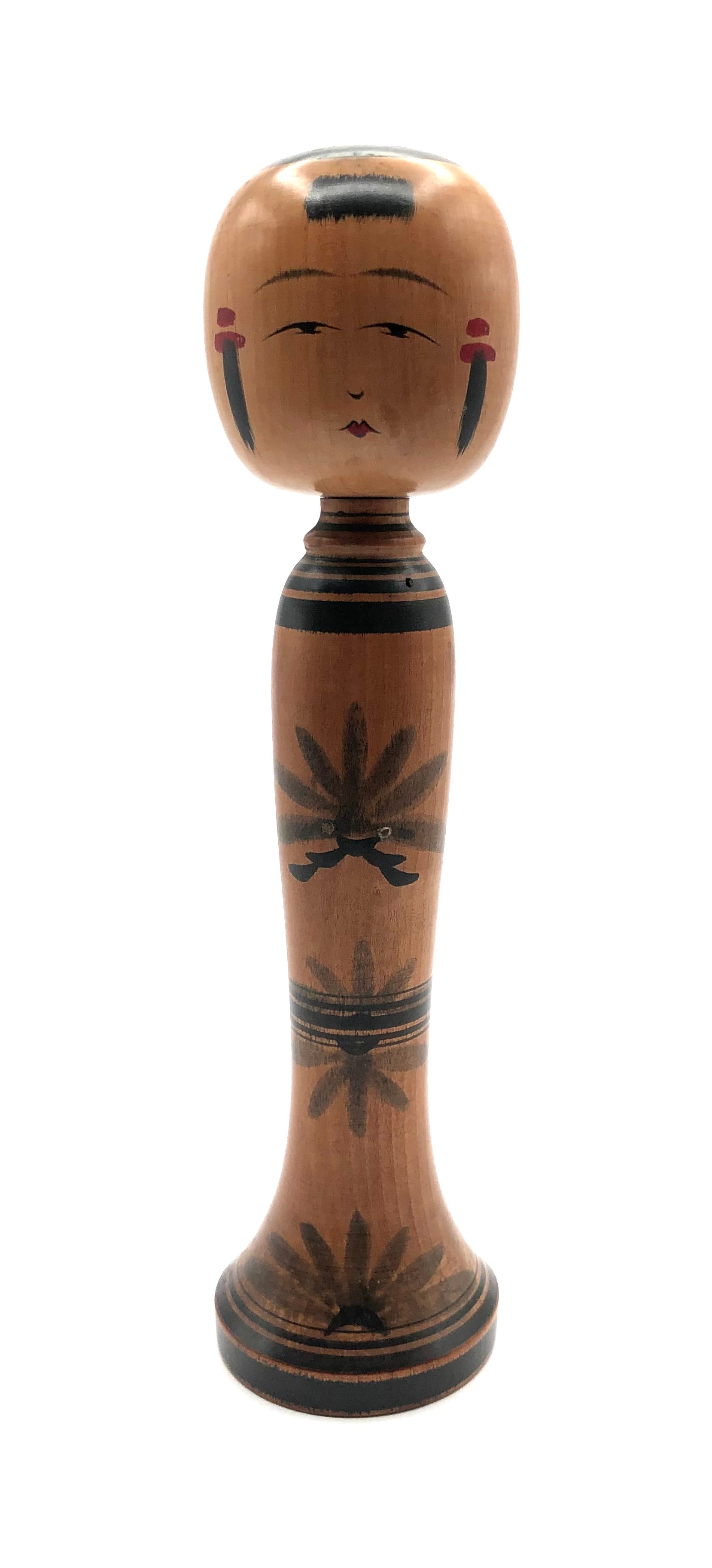
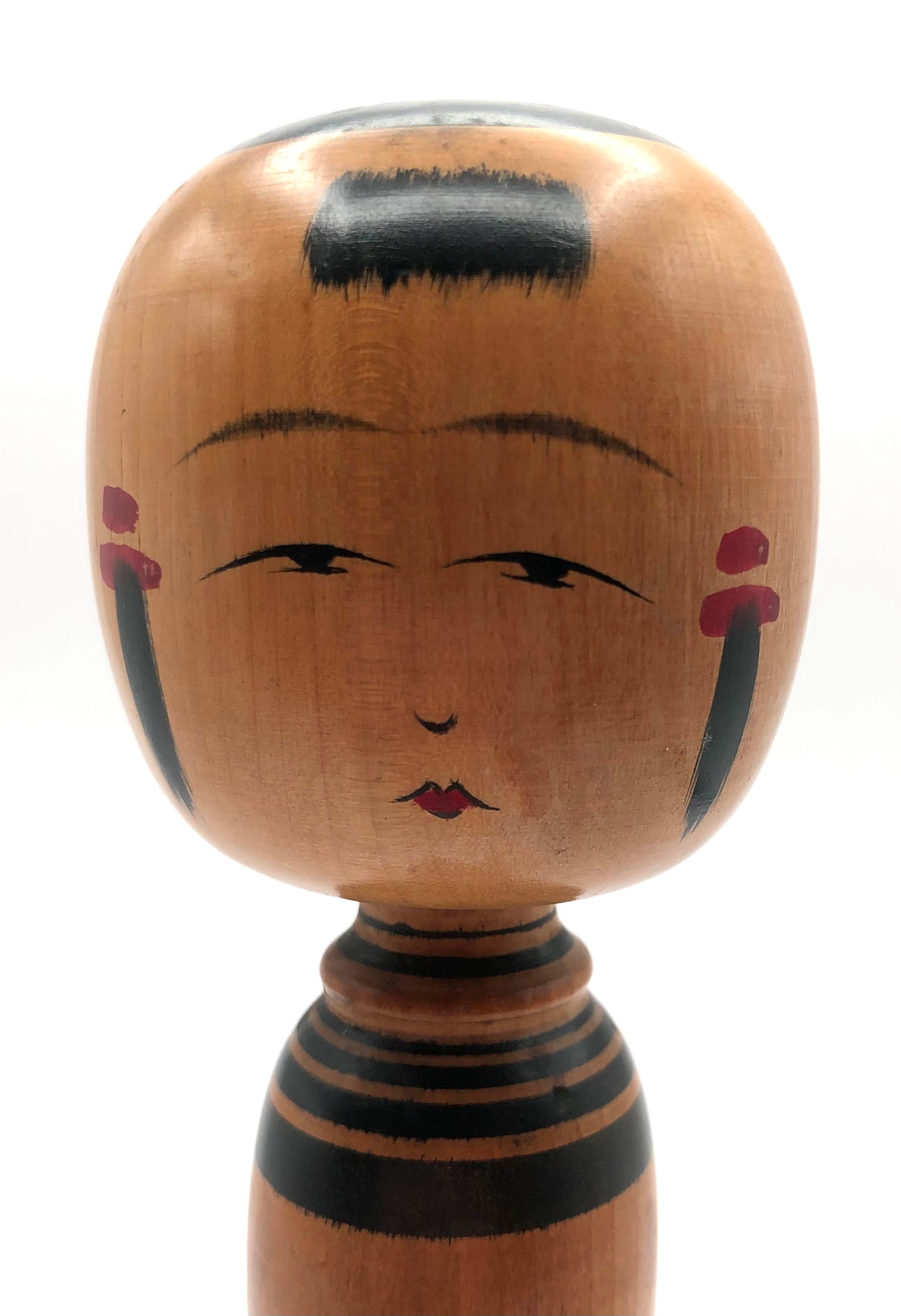
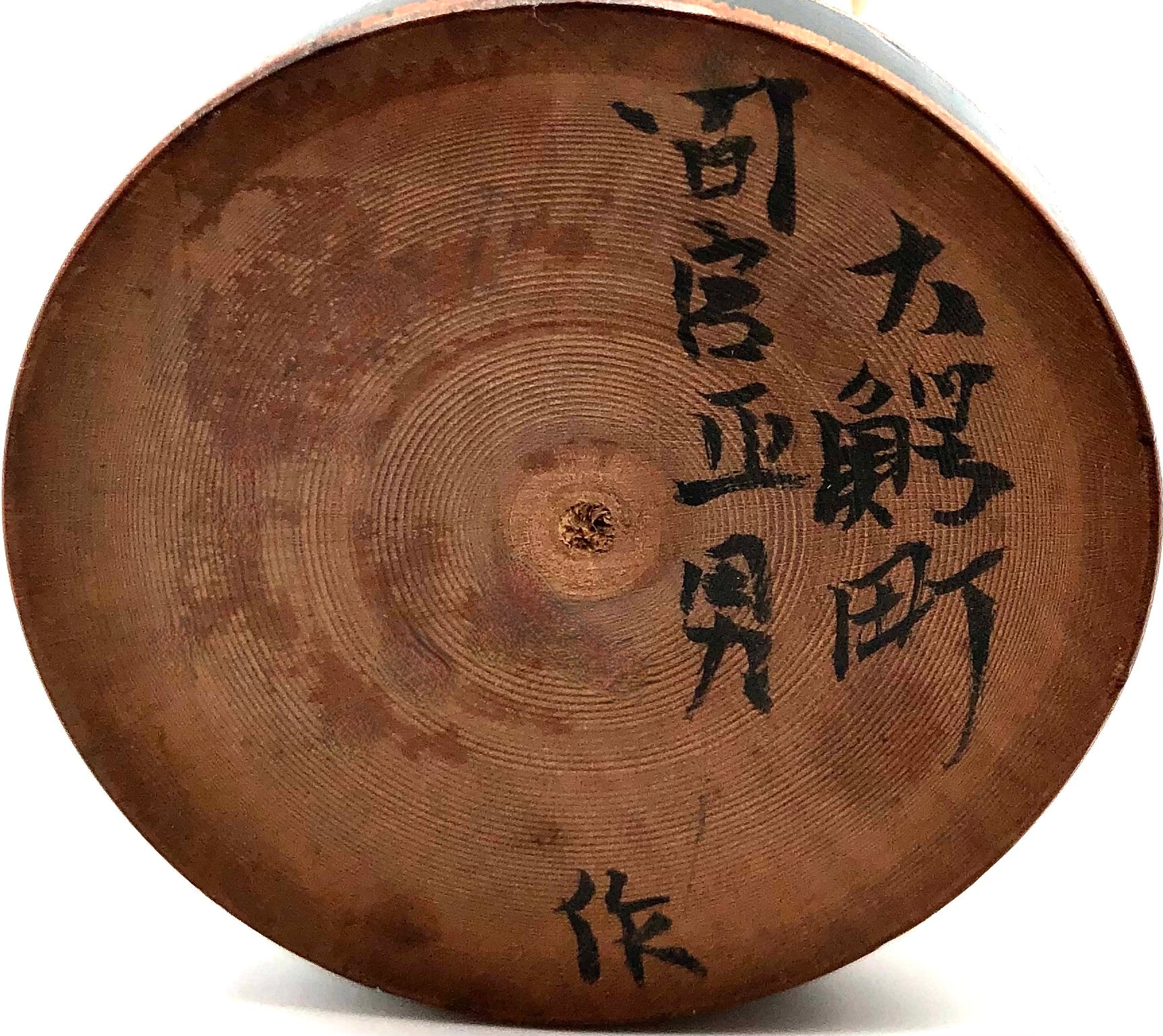
Vintage Japanese Traditional Tsugaru Kokeshi by Mamiya, Masao (1921-)
Dimensions: 9-3/4” h
This Kokeshi is one of the RAREST turned and formed Kokeshi from the Tsugaru-kei family of Traditional doll makers. Mamiya-san studied under Master Mamiya, Meitaro in the mid-20’s. The doll represents a very sophisticated woman from a high-ranking family which, is defined in the total graphics of the doll.
The artist utilized the design of a semi-solid black concentric circle on the top of the head called Janome, and a small patch of bangs above her eyebrows. The basic Tsuchiyu face shows one eyelid with an open eye that looks downward. In many respects, she has a ’stern’ expression, as shown in her eyes and red mouth. She has a ‘cat’ shaped round nose, and long side hair fringes which incorporate red hair ornaments framing the face. This Tsuchiyu utilizes Rokoru moyo style varying widths of horizontal line-work in black below the neck, in the center representing an Obi, and on the base. Interspersed on the body are star Jasmine, (Jasumin) on the front and two interesting tiny, raised dowels of a different type of wood in the middle of the doll. They appear to represent the flowers ‘pistils’, and are only there for a tactile experience. The doll is unusually turned, giving an additional three-dimensional effect at the neck. She is made from one piece of Dogwood wood, (Hanamizuki). We have never seen a Kokeshi with this imaging and quality of work in all the years of our collection. The doll has the acknowledgment on the base in beautiful script and is titled and signed by the artist.
To read more about this Family of Kokeshi makers go to: https://mingeiarts.com/collections/tsuchiyu-kei-family.
Condition: Outstanding, excellent, impressive, and beautiful. ARARE piece for the collector of traditional Kokeshi to complete one’s collection. No chips, cracks, breaks, missing pieces, or restoration, and retains its original details and finish with an exceptional ‘hand’ (touch), including the three-dimensional form, artwork, color, and composition. The piece meets all the standards of the vintage collectible Traditional Tsuchiyu Kokeshi.
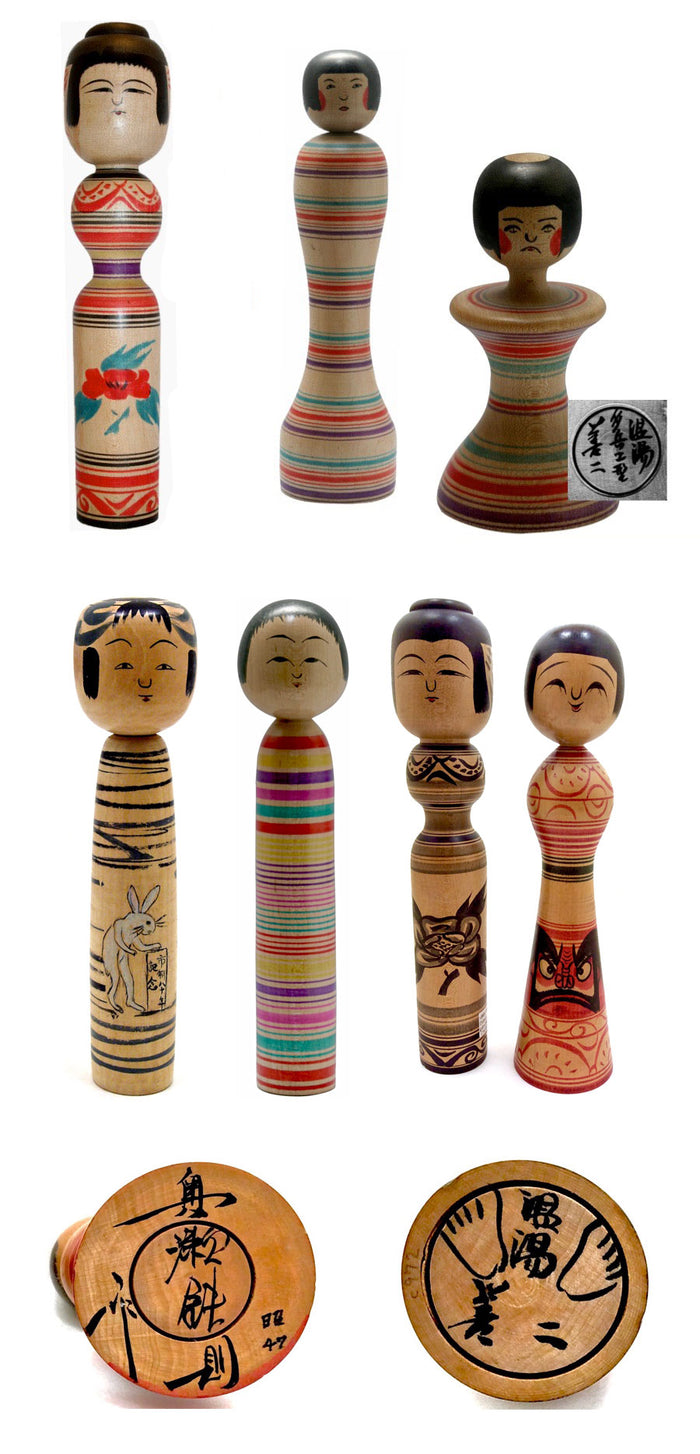
Japanese Traditional Kokeshi
Tsugaru-Kei (Family)
Prefecture: Aomori
Origin:
Tsugaru is the youngest of the eleven traditional kokeshi strains. They began in the 1920s. A Tsugaru doll has a great deal of variety in its shape and pattern. The Tsugaru Kokeshi are made from a solid piece of wood, created using a difficult reverse lathe technique. The Tsugaru Kokeshi is the only strain to still use this method. The Tsugaru-kei developed after adults took an interest in buying more kokeshi as souvenirs from trips to the hot-spring resorts. Tsugaru dolls, which originated in the Aomori Prefecture in the region of the same name, are sometimes also known as Nuruyu dolls, originally fabricated by Hidetaro Mori. They made their appearance at Nuruyu (“lukewarm") Onsen, in the city of Kuroishi.
Collector's note – characteristics/painting style:
The dolls have round chests, thin waists, and cone-shaped lower bodies on which human faces are painted. They will strike you as quite unusual and interesting. One of the distinguishing features of this family of Kokeshi is a heavier hairstyle, in that most are Okappa styling, which has a full head of hair or mostly full head of hair in a bob style, and a chignon or topknot, without much decoration on the head. The hair is painted solid black, with brush strokes visible on the edges of the bangs and hair. One can easily recognize a Tsugaru doll because many will have the face of Daruma painted on the lower half of the body, with flowers painted on the doll looking quite realistic. The short history of the strain may not yet have given it enough time to utilize flowers such as White irises, peonies, and camellias. Stripes (Rokuro Moyo) appear at the top, center, or bottom of the doll. Some doll motifs, such as Ainu (native designs), that replace the Daruma image have simplified versions of peonies, irises, cherry blossoms, and camellia.
NOTE: We have seen a few dolls with the image of Daruma that were created by Sato, Zenji, (b.1925), in which he drew “feet” on the bottom with his signature, which was inspired by his mentor and master, Mori, Hidetori, (b1895), who used the same interesting humorous addition since kokeshi never incorporated feet.

Leading, Craftsmen:
Abo, Muchihide, 1950, (Hirosaki, Aomori) - Master: Sato, Zenji. No additional published information
Mori, Hidetaro, 1895 (Nuruya, Aomori) - Master: Mori, Motokichi. No additional published information
Mori, Mitsuo, 1955 - Masters: Mori, Hidetaro & Shin-ichi. No additional published information
Muramoto, Fumio, 1941- Master, Mori, Senzo. No additional published information
Okuse, Tetsunori, 1940 - Master: Mori, Hidetaro. No additional published information
Sato, Yoshiki, 1949, (Omani, Aomori) - Master: Mori, Hidetaro. No additional published information
Sato, Zenji, 1925, Master: Mori, Hidetaro. No additional published information
Explore & Learn More about Tsugaru-Kei (Family)